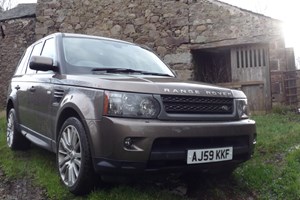Range Rover Sport TDV6

Borrowed Chris Chilton’s Range Rover Sport at the weekend. Lovely as it was, I couldn’t help thinking that a Merc E350 CDI estate would do everything that the Sport is called on to do, but with better economy and emissions, better comfort and better performance. And yet the Range Rover is more S- than E-class when it comes to price.
By Ben Barry
Is the Range Rover Sport a guilty pleasure? 19 May 2010
The vagaries of our long-term fleet diary being what they are, I only drove the Range Rover Sport for the first time the other day. And what a difference the 3.0-litre diesel upgrade has made to the recent 2010 model year facelift.
Where the old 2.7 V6 TD was sluggish and struggled to lug the best part of three tonnes of whopping SUV, the new 3.0 sails along. It’s not what you’d call fast (you need one of the hedonistic V8s for that; the Supercharged is spookily rapid) but it just feels well tuned with the rest of the car. Progress is serene, performance all you need and – as with Jaguar’s application of this engine – the six-speed auto transmission is incredibly well tuned, slushing along when you want to cruise yet holding on to the gears when pressing on. It’s refined and quiet, too.
I only drove the RRS one-up, but it’s easy to see how the car could bolt into family life. It’s been hard to prise assistant editor Chris Chilton away from his beloved Rangie, so smitten is he with its everyday credentials: the kids love the view out, the boot is big and the cabin full of practical touches. Mind you, for such a large footprint, there’s not as much cabin space as you might expect; when we measured them side-by-side my old Citroen C3 Picasso actually had more rear legroom than the Sport.
That slick drive, the easy waftability of the ZF ’box and the imperious driving position that greatly assists my rural commute with its lofty over-hedge view – all conspire to make the Range Rover Sport an endearing prospect. It’s easy to see why it’s the biggest selling Range Rover by far, shifting 45,000 models last year.
But it’s incredible how quickly the zeitgeist has changed. You almost find yourself in apologist mode when you drive a car like this. Especially if you’re driving solo, as most of my weekday driving tends to be – the RRS just feels so big and OTT for everyday driving to the office. Our average consumption of 24mpg and 243g/km of CO2 don’t help your conscience, either.
Family duties and genuine off-road ability clearly provide a whole new spectrum of talent, but the Range Rover Sport’s talents neatly encapsulate the challenges posed to the very future of the SUV. No wonder future derivatives of this model will soon adopt aluminium construction, hybrid power and – in this post-LRX age – perhaps even front-wheel drive. Make no mistake, the most iconic 4x4 of all is changing fast.
resoures : car
0 comments:
Post a Comment